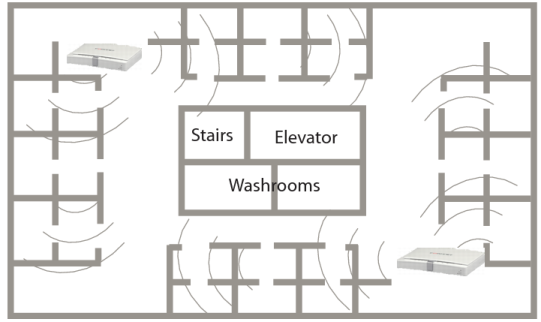Positioning access points
When placing the access point, your main concern is providing a strong signal to all users. A strong signal ensures a fast connection and efficient data transfer. A weaker signal means a greater chance of data transmission errors and the need to re-send information, slowing down data transfer.
Consider the following guidelines when placing access points:
• Physical barriers can impede the radio signals. Solid objects such as walls, furniture and people absorb radio waves, weakening the signal. Be aware of the physical barriers in your office space that may reduce a signal. If there is enough physical interference, you may encounter dead spots that receive no signal.
• Ensure the access point is located in a prominent location within a room for maximum coverage, rather than in a corner.
• Construction materials used in a building can also weaken radio signals. Rooms with walls of concrete or metal can affect the signal strength.
If you cannot avoid some of these impediments due to the shape of the office or building materials used, you may need to use multiple access points to help distribute the radio signal around the room.
Figure 155 shows how positioning two FortiAP-220A units within a uniquely shaped office space helps to distribute signals around the area.
Figure 155: Using multiple APs to provide a constant strong signal.
This sample office has washrooms, a stairwell and an elevator shaft in the center of the building, making it impossible to use a single access point effectively. The elevator shaft and multiple metal stalls in the washrooms can cause signal degradation. However, placing access points in diagonally opposite areas of the office provides maximum coverage.
When using multiple access points, set each access point to a different channel to avoid interference in areas where signals from both access points can be received.

